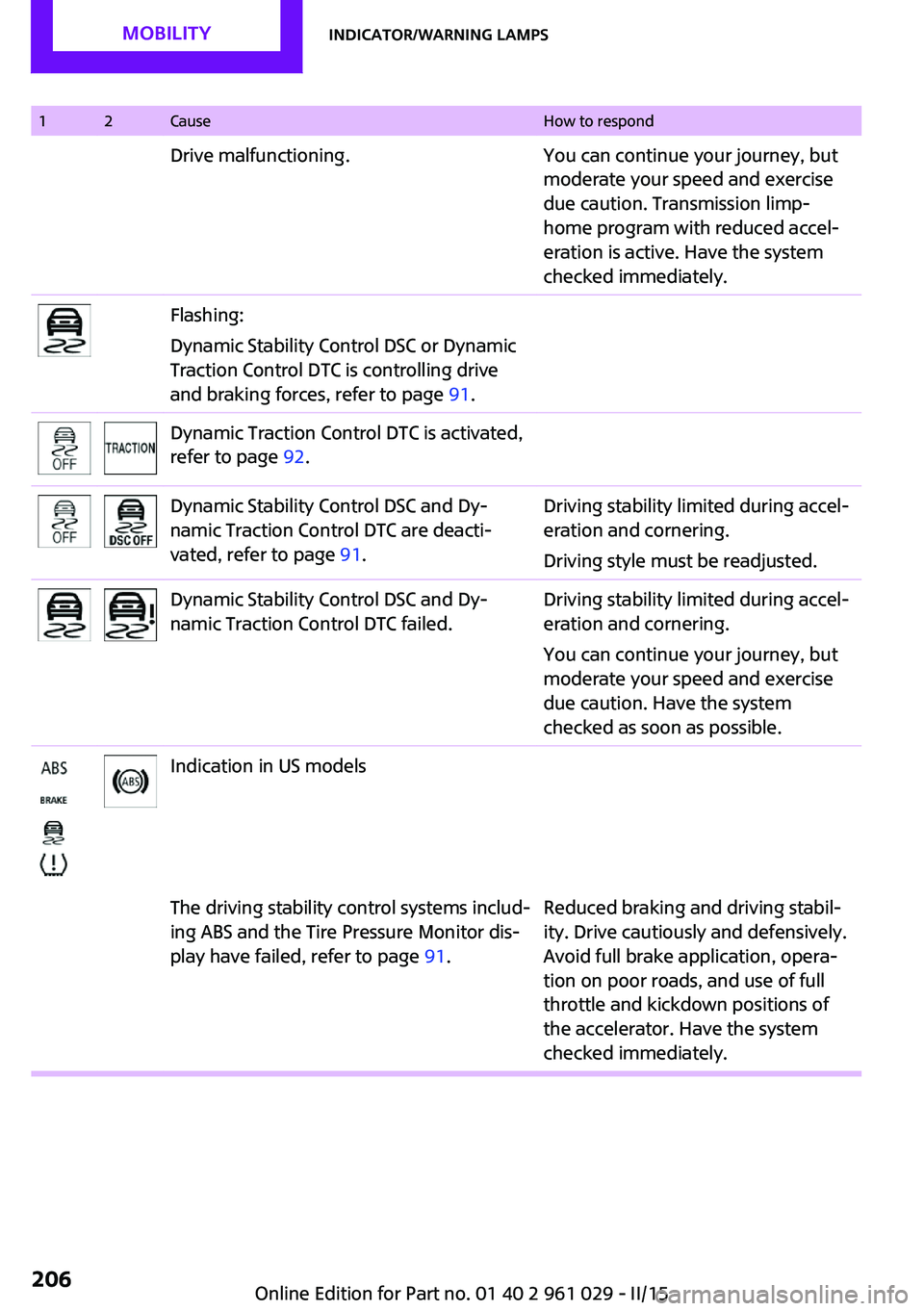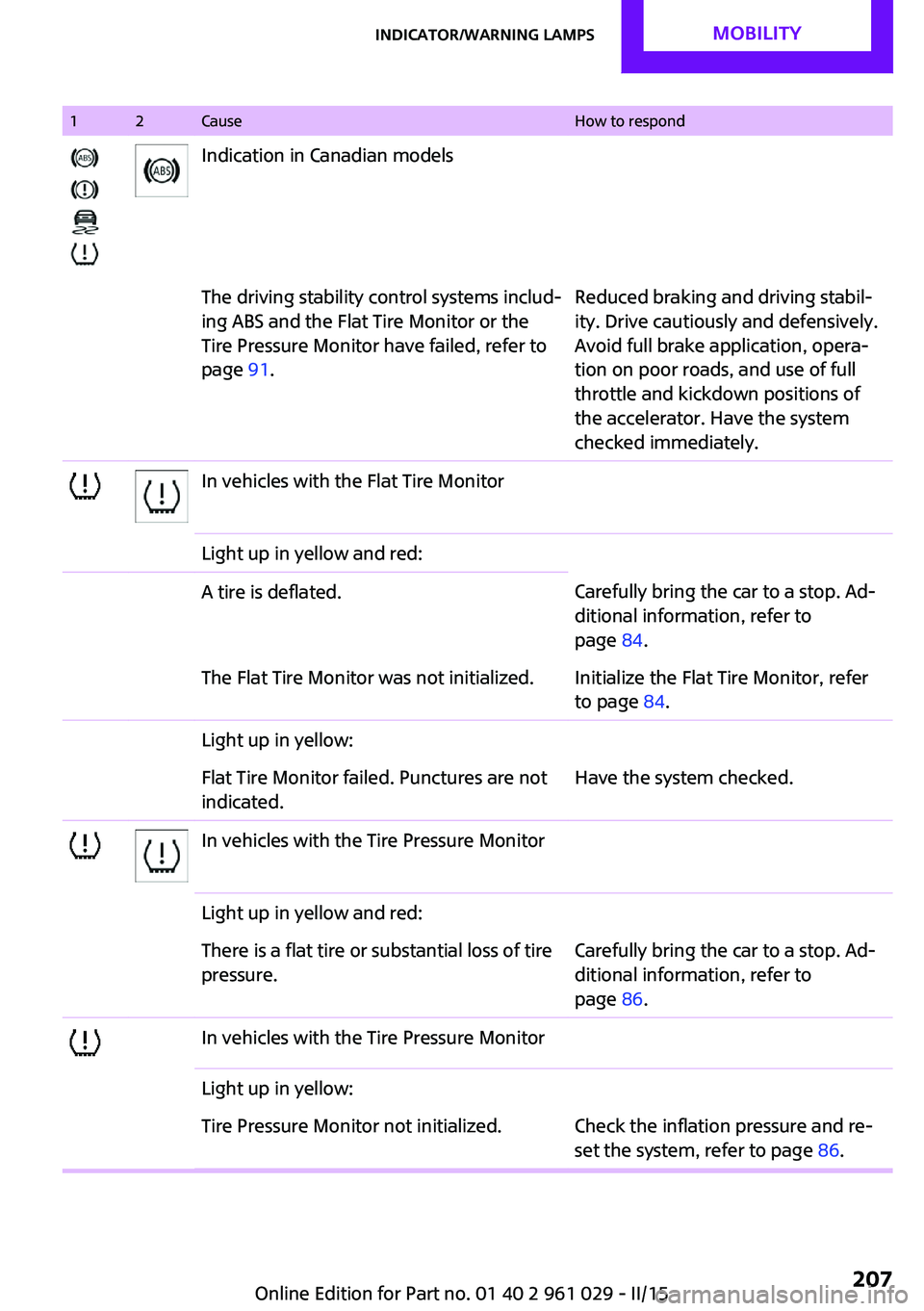2015 MINI COOPER CONVERTIBLE brake
[x] Cancel search: brakePage 199 of 231

Make especially sure that light-colored leather
is cleaned regularly as it is more susceptible to
soiling.
Twice a year, treat the leather with a leather lo‐
tion as dirt and grease will attack the protective
layer of the leather.
Upholstery material care
Vacuum regularly with a vacuum cleaner to re‐
move superficial soiling.
In case of heavy soiling, e.g., beverage stains,
use a soft sponge or lint-free microfiber cloth in
combination with a suitable interior cleaner.
Follow the instructions on the container.
Clean the upholstery material down to the
seams using large sweeping motions. Avoid
rubbing the material vigorously.
Damage from Velcro® fasteners
Open Velcro® fasteners on pants or other
articles of clothing can damage the seat covers.
Ensure that any Velcro® fasteners are closed. ◀
Caring for special components
Interior plastic parts These include:▷Imitation leather surfaces▷Lamp lenses▷Indicator covers▷Matte components
Clean with water and a solvent-free plastic
cleaner if necessary.
Do not use cleansers that contain alcohol
or solvents
Do not use cleansers that contain alcohol or
solvents, such as lacquer thinners, heavy-duty
grease removers, fuel, or such; this could lead
to surface damage. ◀
Rubber seals Only treat with water or a rubber care product.
When cleaning rubber seals, do not use silicone
sprays or other care products containing sili‐
cone; otherwise, noise and damage may result.
Chrome surfaces Carefully clean components such as the radia‐
tor grille or door handles with an ample supply
of water, possibly with shampoo added, partic‐
ularly when they have been exposed to road
salt. For additional treatment, use a chrome
polish.
Light-alloy wheels When cleaning the wheels on the vehicle, only
use a neutral wheel rim cleaner with a pH value
of 5 to 9.
Do not use abrasive cleaners or a steam jet hot‐
ter than 140 ℉/60 ℃; otherwise, damage may
result. Adhere to the manufacturer instructions.
Aggressive, acidic, or alkaline cleaners may de‐
stroy the protective coating of neighboring
components such as the brake disc.
Exterior sensors The sensors on the outside of the vehicle, such
as for Park Distance Control, must be kept clean
and free of ice to ensure that they remain fully
functional.
Decorative trim Clean decorative trims and fine wood compo‐
nents with a moist cloth only. Then dry with a
soft cloth.
Safety belts Dirty belt straps impede the reeling action and
thus have a negative impact on safety.
No chemical cleaning
Do not clean chemically; this can destroy
the webbing. ◀Seite 197CareMOBILITY197
Online Edition for Part no. 01 40 2 961 029 - II/15
Page 202 of 231

12CauseHow to respondLights up briefly:
Approx. 2.1 US gal/8 liters of fuel remain in
the tank.
Remains on:
The remaining range is no more than
30 miles/50 km, refer to page 67.The engine refuses to start.Depress the brake or clutch to start
the engine, refer to page 57.The ignition is switched on and driver's
door is open.Switch off the ignition, refer to
page 56, or close the driver's door.The lights are still switched on.Switch off the lights, refer to
page 75.The roadside parking lamps are still on.Switch off the roadside parking
lights, refer to page 76.A door is open.The hood is open.The tailgate is open.Trunk cover in the MINI ConvertibleThe convertible top cannot be oper‐
ated. Move the trunk cover into the
required position, refer to page 108.Lights up in red:The convertible top is not locked.The convertible top is not locked.
Fully open or close the convertible
top before continuing to drive, refer
to page 42.Sliding sunroof/convertible top.Permissible speed for operation ex‐
ceeded; slow the vehicle and con‐
tinue operating.Seite 200MOBILITYIndicator/warning lamps200
Online Edition for Part no. 01 40 2 961 029 - II/15
Page 204 of 231

12CauseHow to respondThe fuel cap is missing or loose.Make sure that the fuel cap is cor‐
rectly positioned and close it until it
clicks audibly. Do not jam the strap
between the fuel cap and the vehi‐
cle.The windshield washer fluid level is too
low.Add washer fluid, refer to page 62,
as soon as possible.Lights up in red:Service is due.Arrange a service appointment.
Check the service requirements, re‐
fer to page 175.Lights up in yellow:The engine will start the next time the
Start/Stop button is touched, possibly with‐
out the brake or clutch being depressed.The remote control is malfunctioning or, in
cars with Comfort Access, was not de‐
tected.The engine cannot be started. Have
the remote control checked, if nec‐
essary.The battery in the remote control is dis‐
charged.Use the remote control for a longer
journey or, in cars with Comfort Ac‐
cess, replace the battery.The belt tensioners and/or airbag system
has failed.Have the system checked immedi‐
ately.
Fasten the safety belts anyway.Steering assistance has failed.You can continue your journey, but
moderate your speed and exercise
due caution. Markedly different
steering response. Have the system
checked as soon as possible.Lights up in red:Engine malfunctionStop the car and switch off the en‐
gine. You cannot continue your jour‐
ney. Contact your service center.Seite 202MOBILITYIndicator/warning lamps202
Online Edition for Part no. 01 40 2 961 029 - II/15
Page 206 of 231

12CauseHow to respondLights up in yellow:The battery charge level is very low, the
battery is old or is not securely connected.Charge the battery by taking a long
drive or using an external charger. If
necessary, switch off automatic
power consumers. Have the battery
checked as soon as possible.Indication in US models
The parking brake is set.Indication in Canadian models
The parking brake is set.Indication in US models
The parking brake is set while driving.Release the parking brake.Indication in Canadian models
The parking brake is set while driving.Release the parking brake.Indication in US modelsLights up in red:
The brake fluid level is too low.Reduced braking effect, stop the car
carefully. Contact the nearest service
center.Indication in Canadian modelsLights up in red:
The brake fluid level is too low.Reduced braking effect, stop the car
carefully. Contact the nearest service
center.Indication in US models.Brake pads worn.Have the condition of the brake pads
checked without delay.Seite 204MOBILITYIndicator/warning lamps204
Online Edition for Part no. 01 40 2 961 029 - II/15
Page 207 of 231

12CauseHow to respondIndication in Canadian modelsBrake pads worn.Have the condition of the brake pads
checked without delay.Indication in US modelsThe vehicle electronics have failed.You cannot continue your journey.
Contact your service center.Indication in Canadian modelsThe vehicle electronics have failed.You cannot continue your journey.
Contact your service center.Lights up in red:Have the system in question
checked immediately.The starter has failed orThe engine cannot be restarted.Ignition malfunctioning. The engine can
only be restarted when the brake is de‐
pressed or
Lighting system failed. Low beams/tail
lights and brake lights still operational. All
other lights failed.Depress the brake to restart the en‐
gine.Lights up in yellow:Brake light control failed or
The fuel supply is malfunctioning.You can continue your journey, but
moderate your speed and exercise
due caution. Have the system in
question checked immediately.Seite 205Indicator/warning lampsMOBILITY205
Online Edition for Part no. 01 40 2 961 029 - II/15
Page 208 of 231

12CauseHow to respondDrive malfunctioning.You can continue your journey, but
moderate your speed and exercise
due caution. Transmission limp-
home program with reduced accel‐
eration is active. Have the system
checked immediately.Flashing:
Dynamic Stability Control DSC or Dynamic
Traction Control DTC is controlling drive
and braking forces, refer to page 91.Dynamic Traction Control DTC is activated,
refer to page 92.Dynamic Stability Control DSC and Dy‐
namic Traction Control DTC are deacti‐
vated, refer to page 91.Driving stability limited during accel‐
eration and cornering.
Driving style must be readjusted.Dynamic Stability Control DSC and Dy‐
namic Traction Control DTC failed.Driving stability limited during accel‐
eration and cornering.
You can continue your journey, but
moderate your speed and exercise
due caution. Have the system
checked as soon as possible.Indication in US modelsThe driving stability control systems includ‐
ing ABS and the Tire Pressure Monitor dis‐
play have failed, refer to page 91.Reduced braking and driving stabil‐
ity. Drive cautiously and defensively.
Avoid full brake application, opera‐
tion on poor roads, and use of full
throttle and kickdown positions of
the accelerator. Have the system
checked immediately.Seite 206MOBILITYIndicator/warning lamps206
Online Edition for Part no. 01 40 2 961 029 - II/15
Page 209 of 231

12CauseHow to respondIndication in Canadian modelsThe driving stability control systems includ‐
ing ABS and the Flat Tire Monitor or the
Tire Pressure Monitor have failed, refer to
page 91.Reduced braking and driving stabil‐
ity. Drive cautiously and defensively.
Avoid full brake application, opera‐
tion on poor roads, and use of full
throttle and kickdown positions of
the accelerator. Have the system
checked immediately.In vehicles with the Flat Tire MonitorLight up in yellow and red:A tire is deflated.Carefully bring the car to a stop. Ad‐
ditional information, refer to
page 84.The Flat Tire Monitor was not initialized.Initialize the Flat Tire Monitor, refer
to page 84.Light up in yellow:Flat Tire Monitor failed. Punctures are not
indicated.Have the system checked.In vehicles with the Tire Pressure MonitorLight up in yellow and red:There is a flat tire or substantial loss of tire
pressure.Carefully bring the car to a stop. Ad‐
ditional information, refer to
page 86.In vehicles with the Tire Pressure MonitorLight up in yellow:Tire Pressure Monitor not initialized.Check the inflation pressure and re‐
set the system, refer to page 86.Seite 207Indicator/warning lampsMOBILITY207
Online Edition for Part no. 01 40 2 961 029 - II/15
Page 210 of 231

12CauseHow to respondThe small light flashes yellow and then
stays on, the large light lights up in yellow:Tire Pressure Monitor failed. Punctures are
not indicated.Have the system checked.A wheel without TPM electronics is
mounted.Have the system checked.TPM is temporarily malfunctioning due to
other systems or devices using the same
radio frequency.In vehicles with the Tire Pressure MonitorThe small light flashes yellow and then
stays on, the large light lights up in yellow:Tire Pressure Monitor failed. Punctures are
not indicated.Have the system checked.A wheel without TPM electronics is
mounted.Have the system checked.Lights up in red:Transmission limp-home program active
with restricted range of gears, possibly
with reduced acceleration.You can continue your journey, but
moderate your speed and exercise
due caution. Have the system
checked immediately.Gears can be engaged without depressing
the brake.Always depress the brake to engage
a gear.Automatic selector lever locked:Manually unlock the selector lever
lock, refer to page 65.Lights up in yellow:Have the system checked as soon as
possible.Automatic selector lever locked:
The selector lever is locked in position P
with the engine running or the ignition
switched on and the brake depressed orManually unlock the selector lever
lock, refer to page 65.Seite 208MOBILITYIndicator/warning lamps208
Online Edition for Part no. 01 40 2 961 029 - II/15